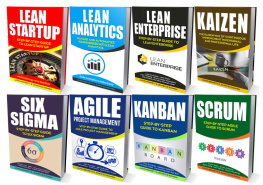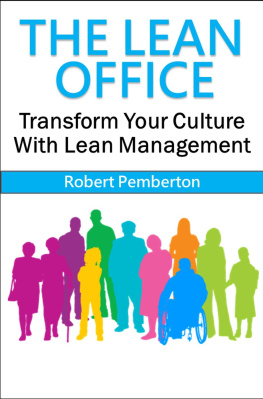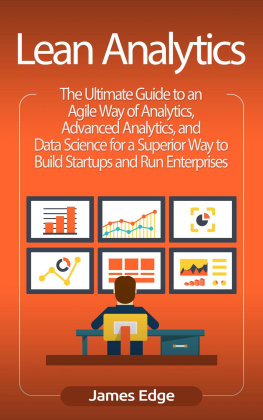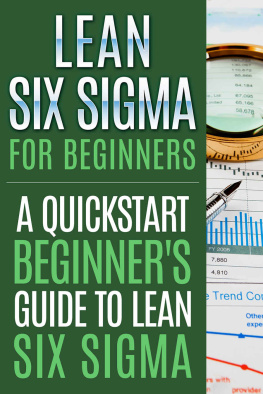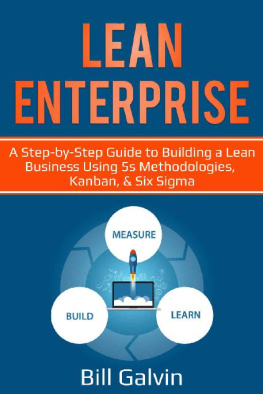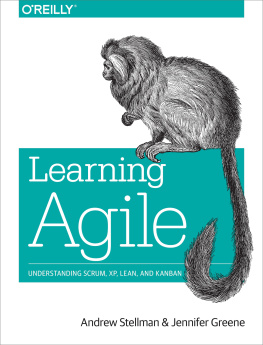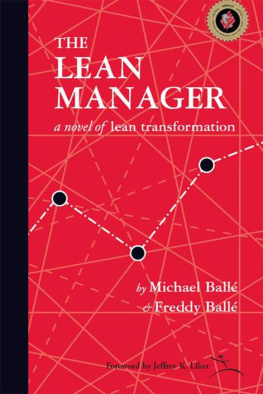LEAN
8-in-1 BOOK
LEAN STARTUP
LEAN ANALYTICS
LEAN ENTERPRISE
KAIZEN
SIX SIGMA
AGILE PROJECT MANAGEMENT
KANBAN
SCRUM
Jason Bennett & Jennifer Bowen
Copyright 2018 - All rights reserved.
The contents of this book may not be reproduced, duplicated or transmitted without direct written permission from the author.
Under no circumstances will any legal responsibility or blame be held against the publisher for any reparation, damages, or monetary loss due to the information herein, either directly or indirectly.
Legal Notice:
This book is copyright protected. This is only for personal use. You cannot amend, distribute, sell, use, quote or paraphrase any part or the content within this book without the consent of the author.
Disclaimer Notice:
Please note the information contained within this document is for educational and entertainment purposes only. Every attempt has been made to provide accurate, up to date and reliable complete information. No warranties of any kind are expressed or implied. Readers acknowledge that the author is not engaging in the rendering of legal, financial, medical or professional advice. The content of this book has been derived from various sources. Please consult a licensed professional before attempting any techniques outlined in this book.
By reading this document, the reader agrees that under no circumstances is the author responsible for any losses, direct or indirect, which are incurred as a result of the use of information contained within this document, including, but not limited to, errors, omissions, or inaccuracies.
Table of Contents
LEAN STARTUP
LEAN ANALYTICS
LEAN ENTERPRISE
KAIZEN
SIX SIGMA
AGILE PROJECT MANAGEMENT
KANBAN
SCRUM
Lean Startup
Step-by-Step Guide To Lean Startup Methodology and Models
Jason Bennett & Jennifer Bowen
Table of Contents
Introduction
I want to thank you for choosing this book, Lean Startup
The lean startup method is a tool that transforms a startup into a structured organization. The lean startup gives an entrepreneur a scientific approach to help him or her create and manage a startup to develop a product that the customer wants faster.
This method teaches every aspiring entrepreneur how he or she can begin a startup, what drives the startup, how to steer, how and when to turn when it is necessary to persevere and what must be done to accelerate the business. This method provides a set of principles that help the startup grow into a sustainable company.
There are many startups that start with the idea of developing a product that they believe their customers want. They spend days, weeks, months and years to perfect the product they have in mind without showing the product to the customer.
Since they do not show the product to their customers, there is a higher probability of failure than success. Besides starting a business may seem a little intimidating but it depends on the way you go about it.
There are a few aspects you need to consider if you want to build a lean startup. This book contains all the information you would need to begin a lean startup. Over the course of the book, you will learn what the principles of a lean startup are and how those principles help a startup become a sustainable organization.
The steps charted out in the book are based on the well-known Lean Startup method that was explained by Eric Ries. This book acts as a guide and takes you through the journey of a lean startup in a simple and easy manner.
Chapter One: The Lean Startup Methodology
Eric Ries said that startups could be a success if they follow a certain process. This means that the process can always be learned and those who have experience can also teach them. Every entrepreneur will always wonder whether a startup will fail.
If you wish to begin a lean startup, you must identify a small gap in the market using time and money effectively.
You will need to use different techniques to ensure that your product or service reaches the market in a faster way while also avoiding the production or manufacture of products that no consumer will want.
Most amateur entrepreneurs feel that they are taking a shot in the dark when they are identifying a product or service they can offer to their potential consumers.
But, it does not always have to be a trial and error proposition. If you adapt lean thinking, you will be able to develop ideas and refine them to meet market standards.
Let me show you some principles that will give a start-up a greater chance of making a profit and becoming a success within a limited budget.
Principles of Lean Start-Up
Controlled Use and Deployment of Resources
One of the most important principles of a lean startup is that the startup must use every one of its resources effectively and efficiently. Since most startups do not have enough investment they use the lean business model to encourage the effective deployment and continuous development of the resources that the company does have.
A lean startup must continuously evaluate how the initial investment can be used to meet their targets and their customer requirements. The startup must also ensure that it does not spend more than what is necessary to test, evaluate and refine its products.
If the costs are kept at a minimum, the startup can maximize its profits whenever there is a sale.
Every lean startup is dependent on organic growth since it does not have huge capital investment. When the profits made at the early stages are reinvested in the company, the startup can scale its operations up in a controlled manner without sacrificing quality. This is commonly called innovation accounting. This is covered in detail in the following chapter.
Entrepreneurs are everywhere
Eric Ries believes that every individual in the world is an entrepreneur. There are some successful entrepreneurs who have built their organization in their garage. You can find entrepreneurs in Hollywood, in the IRS and even in well-established organizations. These people are always looking for a way to develop products that increase value to the customer.
Entrepreneurship is management
It is important to remember that every startup is not defined by its products but is an institution. Therefore, there must be a management team in place to understand and develop the startup. This is covered in further detail in the later chapters of the book.
Validated Learning
A startup does not exist only to build products for the customers or to make money. It exists only when the management learns how to build a sustainable business. The learning can be validated through statistic measures by running experiments that test the startups' vision. This concept is covered in further detail in the next chapter.
Innovation Accounting
A startup must focus on the following to improve outcomes and also hold every entrepreneur accountable:
How can progress be measured
How can milestones be set
How can work be prioritized
This requires a new type of accounting for startups, which is covered in the next chapter.
Build-Measure-Learn
Every startup looks for ways to convert its ideas into a product or service and measure how its customers receive that product or service. When they understand the response, they will understand whether they need to pivot or persevere. This process is covered in further detail in the next chapter.
Chapter Two: Lean Startup Models
The lean startup model was introduced in the year 2011, and its impact on the economy has been enormous. The book written by Eric Ries gained immense publicity, and many companies use the information in the book to develop their startups.

